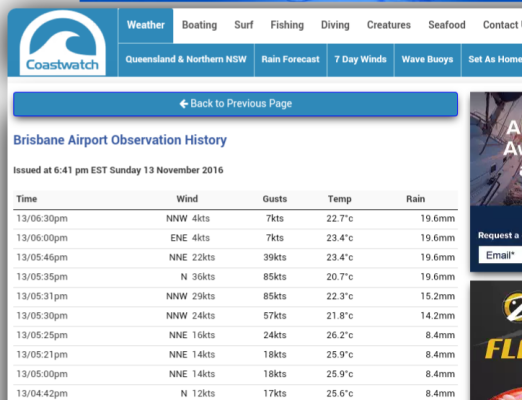When we say “bad” weather, the worst of it for boaters is wind, but several have addressed thunderstorms, so I will, too. While TRWs can cause some nasty wind, it’s rarely threatening to a boat other that a lousy ride for a short time….. but can be, so we need to be prepared.
If we lived in the southeast over to Texas we could avoid all TRWs but we wouldn’t be boating much for 6 months. They are not really hard to deal with. We can’t outrun them but we can maneuver to somewhat avoid them….maybe. For me, on the west coast of Florida, I just ride them out for the most part. There often isn’t room in the intercoastal to maneuver much, and I’m not running off shore to avoid them. Fortunately the air mass afternoon TRWs rarely cause any damage, and normally are not a threat to boaters. You may get wet and cold (or hot if you’re on the enclosed fly bridge without air). And you may have a rocky ride for a bit, but they don’t last long.
Also, storms just don’t “happen”… they don’t just sneak up on us. The conditions that produce storms and especially tornados is quite predictable, and we can get that info in advance, and within 24 hours the predictions are pretty close.
Psneeld mentioned the stability index, called the lifted index. Also is the K index. Both give a good prediction of TRWs. Below are the two charts:
Unisys Weather - Lifted Index - Current
Unisys Weather - K Index - Current
To interpret these charts is pretty easy:
Lifted/K Index
The Lifted/K Index chart is updated twice daily at approximately 0330Z (00Z data) and 1530Z (12Z Data). The Lifted/K Index chart combines two indices commonly used to measure atmospheric instability and the related potential for thunderstorm development. The first, the Lifted Index (upper number), is a measure of the chance of severe thunderstorms. It is the difference between the observed 500 mb temperature and the temperature that a parcel of air would have if lifted from the boundary layer to the 500 mb level. If the temperature at 500 mb is warmer than the parcel lifted to that level, the air is stable and the chance of thunderstorms is low; if the temperature at 500 mb is colder than the parcel lifted to that level, the air is unstable and thunderstorms are likely. The difference in temperature is directly related to the chance of severe thunderstorms.
Lifted Index Chance of Severe Thunderstorms
0 to -2 Weak
-3 to -5 Moderate
-6 or less Strong
The second index, the K Index (lower number), is a measure of the probability of airmass thunderstorms. It takes into account the temperature lapse rate between 850 mb and 500 mb, the amount of moisture at 850 mb, and the dryness of the air at 700mb.
K Index Thunderstorm Probabilty(%)
Less than 15 near 0
15 to 20 20
21 to 25 20 to 40
26 to 30 40 to 60>
31 to 35 60 to 80
36 to 40 80 to 90
Over 40> near 100
Another good chart to get a good idea of future weather is the aviation prog chart. Will give a good idea of fronts and weather 8 days out: (There’s a TON of additional weather products on that site, worth snooping around a bit)
AWC - Prog Charts
I use a lot of aviation stuff, because that’s where the bulk of the weather products are used. Weather stations are at airports, not marinas. I often wish the marinas would simply have a wind meter that we could get wind info with, which would be a good aid for docking.
Now, enough about storms. I’m a strong believer that the biggest threat to a boater is winds. And there’s a number of places we can get winds. Just monitoring the wx channel on VHF gives a pretty good idea, and off shore the buoy reports are good. Also for the off shore guys, Marv (from AGLCA, loopers) is good:
marvs_weather_home_page
Other good wind sites:
https://www.windfinder.com/weather-maps/forecast/usa#6/27.811/-82.812
Tampa Bay Surf Report (STORMSURF)
https://www.windy.com
Now does anyone have a good Iphone app for winds that the text is large enough to read in a boat? All of the above are hard to read on an Iphone.
There’s no reason to be caught with our pants down in severe weather, unless we’re ocean passages makers like Richard on the Dauntless and others, and it’s difficult to do anything but ride it out. I’m not in that league.





